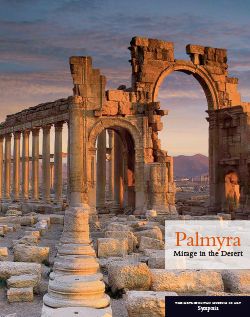Funerary relief
Not on view
Inscription:
1 Maliku, so[n of]
2 Zaba, son of [ ...]
or (son of) Bar[‘ateh?]
Transliteration:
1 mlkw b[r]
2 zbʾ br[ʿth]
This relief is a type of funerary monument characteristic of the prosperous caravan city of Palmyra during the first three centuries A.D. Reliefs with a representation of the deceased and a short identifying inscription were used to seal burial niches in elaborately decorated communal tombs; those with a half-length or bust format became prevalent sometime after A.D. 65.
The relief depicts a beardless young man or boy dressed in a draped garment, probably a Greek-style tunic, with a decorative border at the neckline. He holds a shallow bowl with a diamond-patterned surface in his left hand, carved in high relief; the thumb is modeled completely in the round. His expression is serene, although the intensity of his gaze is emphasized by the large size of his eyes, and the incised iris and drilled pupil of each eye. Tear ducts are indicated at the inner corners, and an incised line above each eye marks the eyebrows. His hair is depicted as a row of uniform wavy curls that cover his head like a cap, ending above the ears. The background of the relief is blank except for an inscription in Palmyrene Aramaic to the left of his head giving his name and lineage. Carved in soft local limestone, the relief shows signs of wear including damage to the nose and mouth, although the outline of the lips remains. The modeling of the cheeks, chin, and the lines across the throat suggest a youthful fullness. Stylistically, the relief can be dated to around 150-200 A.D., evidenced by the figure’s beardlessness, the manner in which the eyes are carved, and the type of attribute he holds.
Due to rights restrictions, this image cannot be enlarged, viewed at full screen, or downloaded.



